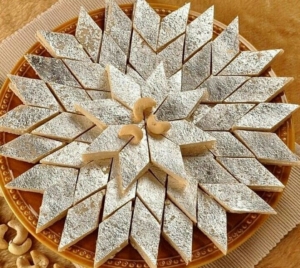Kaju Katli, one of India’s most special desserts, is often trimmed with a thin layer of palatable silver foil, understood as chandi ka varq. While this silver coating adds a hint of grace and artistic value, there has been growing scrutiny about its safety and health importance. This blog delves into the method of making silver foil, possible health risks, and customer understanding of its realism.
The Process Behind Silver Foil Production
Silver foil utilized in Kaju Katli is made by striking silver into fragile sheets, often less than one micrometer wide. Traditionally, crafters used animal hide to beat silver into its mild form, but current methods apply machines and synthetic materials. Despite progress, problems remain about hygiene and impurity.
During peak positive seasons, the need for silver foil surges, leading to problems such as:
- Pollutant with Aluminum: Corrupt manufacturers may substitute silver with cheaper, potentially toxic metals like aluminum
- Use of Heavy Metals: Trails of lead, nickel, or cadmium have been caught in some silver foils, posing serious fitness risks
- Unclean Manufacturing Conditions: Workshops making silver foils might not adhere to strict hygiene standards, raising the risk of contamination
Is Silver Safe to Ingest?
Silver is thought biologically inert, indicating it does not react with bodily fluids or tissues in small amounts. Historically, silver has been used in Ayurvedic medicine for its antimicrobial effects. Nevertheless, the safety of silver foil on food relies on its purity and the lack of impurities.
- Contaminated Silver Risks: Consumption of contaminated or adulterated silver may lead to toxic buildup in the body. Metals like aluminum and cadmium, occasionally found in counterfeit foils, are associated with neurological and gastrointestinal problems.
- Trace Metal Concerns: Chronic exposure to heavy metals in food can contribute to chronic conditions, including kidney injury and resistant suppression.
Silver vs. Aluminum: Remembering the Real Deal
To save consumers, food safety authorities advise verifying the genuineness of silver foil. Some simple ways to differentiate between real silver and reserves include:
- Residue Test
- Rub the foil between your fingers.
- Silver: It has no residue and has its original state.
- Aluminum: Leaves a gray or metallic remains, meaning it is not pure silver.
- Burn Test
- Burn a small piece of the foil using a more light or candle flame.
- Silver: Shrinks into a ball-like form without having residue.
- Aluminum: Leaves after grayish ash or remains upon boiling.
- Acidity Test
- Place a small amount of the foil in cut hydrochloric acid.
- Silver: Responds to form a white residue (silver chloride).
- Aluminum: It does not have such a response and may stay intact.
- Visual and Textural Differences
- Silver: Has a brilliant, smooth, and slightly nostalgic surface. It is very thin and light.
- Aluminum: Seems duller, thicker, and less smooth likened to silver.
- Food Safety Assurance
- Buy sweets with a food safety certificate that ensures the use of pure silver. Look for brands like those required by authorities such as FSSAI (in India).
- Authorized brands often include documentation or markings about the virtue of the foil.
Why It Counts
Destroying counterfeit aluminum foils can lead to fitness issues, including possible heavy metal toxicity, nausea, and long-term risks from disclosure to harmful implications like lead or cadmium.
Being knowledgeable and alert ensures that the artistic and aesthetic importance of silver-coated sweets is maintained without compromising health.
Customers should only buy sweets from trusted agents who provide the use of pure silver foil.

Health Impacts of Prolonged Silver Consumption
While periodic ingestion of real silver foil is improbable to cause harm, duplicated vulnerability raises concerns:
- Argyria: A rare disorder where silver reserves in the body, causing a bluish-gray skin discoloration.
- Metal Toxicity: Impure foils with heavy metals can refer to signs like nausea, abdominal pain, and fatigue
- Allergic Reactions: Though unusual, some people may experience hypersensitivity to silver or its alloys.
Customer Awareness and Food Safety Standards
Awareness about the health importance of silver-coated sweets has grown in recent years. Several communities and food safety officers have issued policies to ensure consumer safety:
- FSSAI Guidelines: The Food Safety and Standards Authority of India requires the use of pure silver in food-grade foil and restricts the inclusion of other metal
- Certification and Labeling: Sweets with simple silver foil are often labeled, assuring quality.
- Encouraging Alternatives: Some manufacturers are shifting to edible options, such as thin sugar sheets or other cosmetic coatings, to mitigate risks
Artistic and Symbolic Meaning
The silver coating on Kaju Katli has deep cultural and symbolic significance, expanding beyond its aesthetic charm to embody notions of prosperity, luxury, and festivity in Indian traditions. This thin layer of edible silver foil, known as chandi ka varq, changes the sweet into a symbol of opulence and reverence, particularly during certain occasions like Diwali, Ganesh Chaturthi, and weddings.
A Character of Wealth and Prosperity
In Indian culture, silver has long been associated with wealth, purity, and good fortune. Including silver foil on Kaju Katli improves its value, symbolizing a wish for wealth and abundance for the recipient. This practice aligns with the festive spirit, where communicating luxurious and well-crafted sweets is a gesture of goodwill and celebration.
Improving the Festive Appeal
Kaju Katli is a staple during festivals, and its silver layer amplifies its festive charm. The glistening foil symbolizes light and brightness, coordinating with the ethos of festivals like Diwali, which celebrates the victory of light over darkness. This graphic element adds an extra layer of joy to the production of sweets.
A Motion of Respect and Reverence
In many Indian households, silver-coated sweets like Kaju Katli are delivered to deities during religious ceremonies, symbolizing purity and devotion. The use of silver aligns with conventional beliefs that associate the metal with spiritual meaning and sanctity.
Artistic Heritage and Craftsmanship
The tradition of using chandi ka varq dates back to ancient times, showcasing the detailed craftsmanship applied in pounding silver into ultra-thin sheets. This method is not merely useful but a reflection of the artistry and artistic legacy covering Indian sweets.
Gift of Elegance
Kaju Katli decorated with silver foil is often given as a bonus gift, suggesting the giver’s thoughtfulness and high regard for the recipient. It echoes a blend of taste and sophistication, making it an excellent present for celebratory moments.
Global Award of Indian Sweets
The silver coating on Kaju Katli has evolved into a marker of realism and luxury, elevating its status in the international culinary landscape. It embodies the rich practices of Indian sweets and their importance in celebrating life’s milestones.
The silver layer on Kaju Katli is much more than a decorative element; it encapsulates centuries of tradition, artistry, and artistic significance, making this dessert a continuing symbol of joy, prosperity, and festival.
Tolerable and Ethical Choices
Amid rising concerns, some manufacturers are researching sustainable and ethical approaches:
- Edible Coatings: Alternatives like vegetable-based edible films or natural food colors deliver a safe and eco-friendly option.
- Modern Techniques: Machine-made silver foils decrease the risk of contamination compared to traditional methods.
- Consumer Advocacy: Improved demand for transparent labeling and honest production practices enables manufacturers to adhere to safety standards.
Deduction
The silver coating on Kaju Katli embodies the dignity and cultural depth of Indian sweets, remembering tradition and luxury. Yet, it also brings attention to possible health risks due to adulteration and dirty manufacturing practices. While pure silver is mostly safe and biologically inert, counterfeit foils made with aluminum or other toxic metals raise important health concerns, such as heavy metal toxicity and allergic reactions.
Key References:
- Adulteration: Unprincipled manufacturers may replace silver with cheaper, harmful metals like aluminum, which can have negative health effects
- Hygiene Issues: The display of silver foil in unregulated conditions can lead to contamination, putting customer health at risk【9】.
- Chronic Exposure Risks: Long ingestion of contaminated or contaminated foil may induce neurological and gastrointestinal issues.
Customer Action:
- Choose Trusted Brands: Opt for plants that comply with food safety rules, such as those approved by the Food Safety and Standards Authority of India (FSSAI).
- Educate Yourself: Learn to determine genuine silver from reserves using simple tests like the residue or burn test.
- Advocate for Alternatives: Many labels are exploring tolerable, food-safe coatings like palatable films or sugar decorations.
As understanding grows, the industry may shift toward safer, more translucent practices, ensuring that the magic and luxury of Kaju Katli remain intact while prioritizing customer well-being. By staying educated, consumers can observe traditions without compromising health.
All images only use for enterainment purpose.







